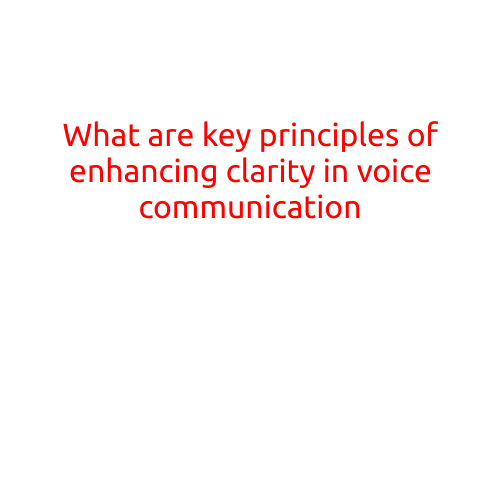
What are the Key Principles of Enhancing Clarity in Voice Communication?
Effective voice communication is a crucial aspect of personal and professional relationships. When you communicate clearly, you convey your message efficiently, build trust, and avoid misunderstandings. In today’s fast-paced world, where verbal communication is increasingly important, developing the skills to enhance clarity in voice communication is essential. In this article, we will explore the key principles that will help you communicate more effectively and with greater clarity.
1. Purposive Communication
The first principle of enhancing clarity in voice communication is to identify your purpose. Before speaking, define what you want to achieve from the conversation. This will help you focus on the key message and avoid unnecessary information. Purposive communication ensures that your message is concise, relevant, and effective.
2. Clear Language
Using clear language is essential for effective voice communication. Avoid using jargon, technical terms, or complex vocabulary that might be unfamiliar to your audience. Instead, opt for simple, concise language that conveys your message efficiently. Consider the audience’s level of understanding and adjust your language accordingly.
3. Enunciation and Articulation
Good enunciation and articulation are critical for clarity in voice communication. Speak slowly and clearly, pausing between sentences to emphasize important points. Avoid mumbling, whispering, or speaking too quickly, which can lead to misunderstandings.
4. Tone and Inflection
Your tone and inflection can significantly impact the clarity of your message. Use a neutral tone to convey confidence and authority, and adjust your inflection to add emphasis or convey emotions. Avoid using a monotone voice, which can lead to boredom and distraction.
5. Active Listening
Effective voice communication is a two-way process. Active listening is essential for clarity, as it allows you to acknowledge and confirm understanding. Repeat back what you’ve heard to ensure that you’ve understood the message correctly, and ask clarifying questions to eliminate misunderstandings.
6. Body Language
Body language plays a significant role in enhancing clarity in voice communication. Maintain eye contact, use open and relaxed body language, and avoid crossing your arms or legs, which can give the impression of defensiveness or closed-off-ness.
7. Structured Communication
Structured communication is crucial for clarity. Break down complex information into smaller chunks, and use a logical sequence to organize your thoughts. Avoid jumping from one topic to another, and provide clear transitions between ideas.
8. Feedback and Confirmation
Feedback and confirmation are essential for ensuring that your message is received and understood correctly. Encourage feedback from your audience, and ask open-ended questions to gauge their understanding. Confirm whether they’ve understood the message correctly, and clarify any doubts or ambiguities.
9. Contextual Awareness
Contextual awareness is critical for clarifying your message. Consider the audience’s background, experience, and level of understanding when communicating. Be aware of cultural differences, idioms, and colloquialisms that might impact understanding.
10. Practice and Reflection
The final principle of enhancing clarity in voice communication is practice and reflection. The more you practice effective communication, the more natural it will become. Reflect on your communication style, identify areas for improvement, and work on developing your skills.
In conclusion, enhancing clarity in voice communication requires a combination of skills, including purposed communication, clear language, enunciation, and active listening. By following these key principles, you can improve the effectiveness of your communication, build stronger relationships, and achieve greater success in your personal and professional life.





